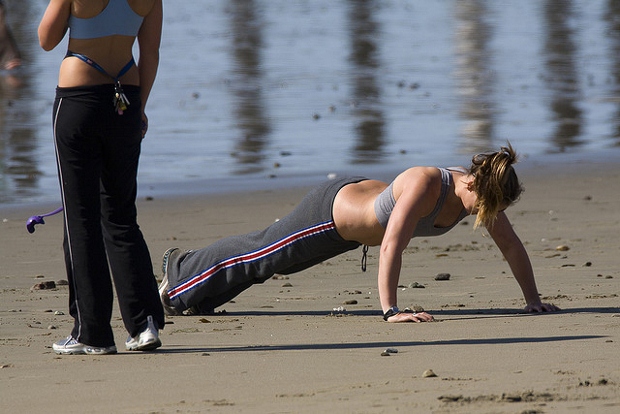What if you’re just starting to run as a complete beginner? This post is for you.

New runners face a unique dilemma: the motivation to run and achieve big goals is high, but your aerobic and muscular fitness is low. That’s a potentially dangerous combination, so this article will help you start running safely and put you on the quickest path to running fast.
Every new runner has questions about how to start.
- How do I run and prevent injuries?
- What mileage should I start running?
- When can I run my first race?
- Should I run alone or with a group?
The most important element of beginning running is your foundation. This includes general health, aerobic fitness, and the structural capacity to run without getting injured.
Health Comes First
Before you start an introductory training program (like the 5k Roadmap), you first have to be healthy. Old injuries from other sports, fatigue from illness, or even bad habits like smoking will make your transition from non-runner to runner much more difficult.
Enlist the help of friends and family to help you succeed in getting as healthy as possible. Use an accountability tool like Stickk to ensure you kick your bad habits of watching 4 hours of TV or ripping through a pack of cigarettes every day. Remember – small steps every few days amount to massive change in the long-term so stay patient.
Your diet plays a huge role in your health and day to day ability to run, recover, and adapt to the stress of training. A modified paleo diet might be the best way for you to lose weight and start your running program.
If you want to start more aggressively, move to a full paleo diet and ditch the grains, starches, and processed foods. Just realize that as your training increases, you’ll need some carbohydrates to fuel your running.
My favorite healthy sources of carbohydrate include:
- Sweet potatoes (or yams)
- Wild rice
- Quinoa
- Fruit
There are other quality sources of carbs (oatmeal, sprouted bread, etc.) and you can be more liberal with your choices once you’re at your goal weight and your training volume is higher, but if you’re trying to lose weight, stick to these carb sources. Above all else, avoid sugary snacks or “white carbs” like bagels, muffins, donuts, or pasta that spike your blood sugar and don’t offer a lot of nutrients.
Recommended resource: In Defense of Food: An Eater’s Manifesto by Michael Pollan
Increasing Your Endurance
As a new runner, you’re probably itching to run your first race and see how fast you can run. Your aerobic fitness, or endurance, is going to mostly determine your finish time in races of 5k and longer. So that’s what you should focus on first.
For beginners, the biggest hindrance to speed is going to be endurance. Since you haven’t been running for years, it’s naturally going to be low but will increase rapidly once you start training.
Most importantly, you need to start at a modest amount of running volume and number of days per week of training. For most people at their goal weight, 3-4 days of running of 20-30 minutes is a practical starting point. But this is intensely personal – do what works for you and always err on the side of running too little.
One of the best ways to increase your endurance without the risk of injury is to include zero-impact cross-training into your program, like cycling or pool running. Both are more specific to running than swimming so they’ll provide better adaptations suited to the sport of running. Since there’s no impact on your joints, tendons, and muscles you’re far less likely suffer an overuse injury.
If you’re running three times a week for 30 minutes, you can add another 3-4 cross-training sessions at 30-60 minutes. By adding these sessions, you’ll rapidly develop your aerobic fitness with virtually no injury risk.
Cross-training can dramatically improve your fitness, but make sure you do it right:
- Never add a cross-training session on a long run day – you’ve already done enough
- A short and easy spinning or pool running session in the afternoon after a hard workout can help you recover more quickly
- Longer or harder cross-training workouts should be done on days you’re doing standard distance runs (or “maintenance” runs) of average mileage
- You can add a short pool or cycling session on your easy run day (or rest day), but only if you’re running high mileage. It will help you recover, but use your day off as productively as possible and err on the side of complete rest.
- Whether you’re cycling or pool running, keep your leg cadence at 90 rotations per minute or higher
Foundational Fitness: How Strong is Your Structural Support?

Running is a skill-sport. There’s no question about it. Training consistently over weeks and months without injury takes coordination, strength, and athleticism. As you start running, it’s important to build a solid foundation that includes general strength and flexibility exercises.
These exercises include gym workouts with weights, body-weight exercises that can be done at home, and dynamic stretches that keep your legs loose. Without them, you’ll likely create muscle imbalances and lack the stretch needed to run healthy and at your best.
In Christopher McDougall’s best-seller Born to Run, he transforms himself from an injury-prone jogger to an ultra-runner who completed a 50 mile ultra-marathon in the rugged canyons of Mexico. Most of the public thinks he did this because of his barefoot running (he actually didn’t do much). I think his success can mostly be attributed to his consistent general strength exercises. They included squat-jumps, medicine ball work, and lunges that helped him prevent the injuries he was so prone to beforehand.
Getting started with these routines is simple – start with 5 minutes of these exercises before you run and end with 10 minutes after you run. My favorite exercises and routines:
- The Standard Core Routine (after you run)
- The ITB Rehab Routine (after you run)
- The Standard Warm-up (before you run)
- Myrtl Routine (before or after you run)
- Hay Bales (you need a medicine ball for these): these are essentially squats with a med ball except you raise the ball above your head and twist to the side as you raise it. These can be done before you run if you’re more advanced, but usually do them after you run.
The benefit of putting these exercises into a “routine” is that you don’t have to plan each exercise out. As a beginner, it’s easy to put on a video and follow along. After a week of going through each routine you’ll have committed it to memory and you can complete each one in about 10 minutes.
The mobility exercises include in the Myrtl routine and the Standard warm-up help you literally warm up before a run and increase your range of motion. Static stretching can actually increase your chances of getting hurt and hurt your performance. Instead, stick to dynamic stretches that better prepare you to run. With warm legs, lubricated joints, and better injury protection you’ll start running on the right foot. Or your left, if you’re into that kind of thing.
Recommended Resource: CoachJayJohnson.com
Boosting Your Mileage (the right way)
I’m not convinced the 10% Rule is the best way for runners to increase their mileage. In its essence, the 10% Rule says you shouldn’t add more than 10% of your weekly mileage to your next week of running. So if you’re doing 10 miles this week, you should only do 11 miles next week.
For beginners, this is far too simplistic. Most runners should start with 2-3 runs per week of 1-4 miles, with plenty of strength work to prevent common injuries like plantar fasciitis or shin splints. Don’t bump up your mileage every week – instead, keep it the same for 2-3 weeks to let your body adapt to the new stress and then add more miles once you’re comfortable with the mileage level you’re running.
Let’s look at an example:
If you’re running three days per week of 3, 4, and 5 miles as your long run and you’re comfortable with this mileage, you can add another day of running to your schedule. Including another 3 mile day is perfectly reasonable (as long as you’re comfortable with 12 miles a week and you’ve been doing your strength work) even though it’s a 25% increase. With three recovery days, your body likely won’t have a problem adjusting to this new stress.
Once you’ve been running more and you understand what your body is capable of, you’ll find that you have a mileage “baseline” that you’re comfortable with. For me, that’s about 60-70 miles a week. My body handles that volume just fine and I can increase my mileage dramatically to that level. After 70 miles per week I have to add mileage more cautiously than 10% per week.
Always be careful when you’re increasing mileage – that’s when injuries typically happen. Pay attention to the feedback that your body is giving you and focus on the little things: extra sleep, a good runner’s diet, and your strength and mobility routines. It’s a good idea to practice some self-massage on your tight areas with a foam roller.
Recommended Resource: Daniels’ Running Formula by Jack Daniels
TO DO: This week pick one thing from this post and implement it in your running. Add a core routine, reevaluate how you’re increasing mileage, or start eating a better diet to get healthy. No matter what you choose, your running will improve. Let me know in the comments below how you improved!
New runners! NOW is the time to get healthy and start running the right way. If you’re still not sure where to start and want a detailed training plan (plus the exact strength exercises you need to stay healthy), check out Injury Prevention for Runners.
Once you implement these principles, you’re going to see dramatic improvement from consistent running. You’ll be lapping those other newbies still struggling through Week 3 of Couch to 5k.